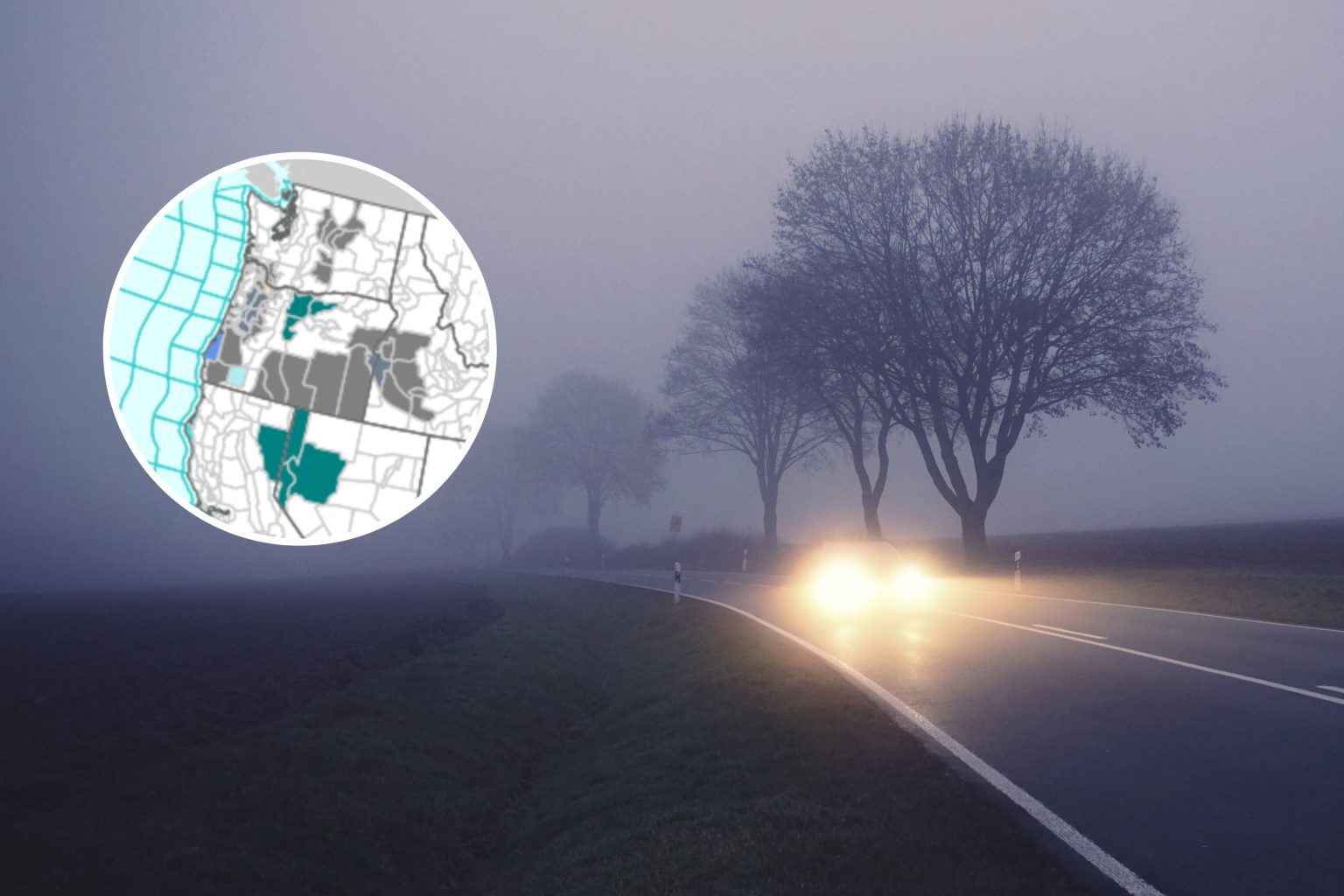Summarize this content to 2000 words in 6 paragraphs A blanket of thick fog has descended over the Northwest as December weather seizes the country.A “Dense Fog Advisory” has been issued by the National Weather Service for much of Oregon, along with small sections of Idaho.”Air Stagnation Advisories” have also been issued across Oregon, Idaho and parts of Washington.”Stagnant air conditions over parts of the Pacific Northwest, leading to areas of dense fog and poor air quality,” the NWS said in a short range public discussion.These atmospheric conditions may lead to “hazardous” conditions on the roads, with the NWS advising drivers to take care.
Stock image of a car on a foggy road (main) and NWS map of Dense Fog and Air Stagnation Advisory areas (inset). Areas affected by the Dense Fog and Air Stagnation Advisories are grey, while…
Stock image of a car on a foggy road (main) and NWS map of Dense Fog and Air Stagnation Advisory areas (inset). Areas affected by the Dense Fog and Air Stagnation Advisories are grey, while dark green areas are under a Freezing Fog Advisory.
More
ISTOCK / GETTY IMAGES PLUS / NWS
What does a Dense Fog Advisory mean?The NWS explains that a Dense Fog Advisory is put into place “when widespread fog is expected to reduce visibilities to 1/4 mile or less over a large area for an extended period of time (2 or more hours),” while an Air Stagnation Advisory is given when “major buildups of air pollution, smoke, dust, or industrial gases are expected near the ground for a period of time.”The Dense Fog Advisories will continue until around 11 a.m. local time today, but the Air Stagnation Advisories will mostly stretch into Wednesday evening, while some will continue into Thursday or even Friday in some regions.”If driving, slow down and leave plenty of distance ahead of you. Pedestrians and cyclists should wear bright or reflective clothing to increase the chances of being seen by others in poor visibility conditions,” the NWS said in a statement.They added: “Low visibility could make driving conditions hazardous.”⚠️Be prepared for Dense fog tonight through the Monday morning commute in the lower Treasure Valley. Visibilities of a quarter mile or less is expected especially along I-84 from Caldwell, Idaho through Huntington, Oregon. #idwx #orwx pic.twitter.com/lp4XZ4cMXM— NWS Boise (@NWSBoise) December 2, 2024
Dense fog forms when the air near the ground cools to a point where its water vapor condenses into tiny liquid water droplets, creating a cloud at the surface. This requires high humidity, cool temperatures and little to no winds.There have also been “Freezing Fog Advisories” issued across Nevada, Oregon, and Northern California.”Visibility less than half a mile in freezing fog with some locally dense freezing fog with less than one quarter of a mile visibility,” the NWS said in a statement.”Low visibility could make driving conditions hazardous. The freezing fog can also cause slick conditions on roads, especially on bridges and overpasses.”🌫️ Areas of dense fog and freezing fog are occurring this morning (Dec 1st) across the central & northern Willamette Valley, Lower Columbia, and southwest WA lowlands.⚠️ If driving, slow down, use your low beam headlights, and leave plenty of distance ahead of you. #ORwx #WAwx pic.twitter.com/7gYQtyCl1y— NWS Portland (@NWSPortland) December 1, 2024
This foggy weather and air stagnation are being caused by a high-pressure system preventing vertical mixing, which would normally disperse pollutants.These pollutants then build up in a confined area, resulting in degraded air quality, which may affect people with respiratory conditions and other health concerns.”An Air Stagnation Advisory indicates that due to limited movement of an air mass across the advisory area, pollution has the potential to increase to dangerous levels,” the NWS said in a statement.These conditions can be dangerous for people with respiratory illnesses, and may be exacerbated by nearby fires, as the pollutants from the smoke will also be trapped in the same area.Stable air and light winds can lead to the build up of air pollution in valleys the next few days. Reduce activities that contribute to air pollution, such as outdoor burning, residential wood burning, vehicle trips, and vehicle idling. #orwx #wawx pic.twitter.com/nJWS3bFZ2P— NWS Portland (@NWSPortland) November 30, 2024
“State air quality agencies highly recommend that no outdoor burning occur and that residential wood burning devices be limited as much as possible,” the NWS said.”According to state air quality agencies, prolonged periods of stagnant air can hold pollutants close to the ground, where people live and breathe.”Do you have a tip on a science story that Newsweek should be covering? Do you have a question about fog? Let us know via science@newsweek.com.


